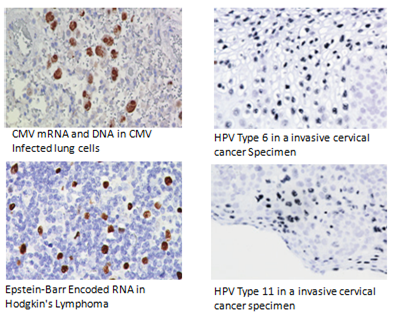- You are here: Home
- Services
- ISH/FISH Services
- FISH Applications
- In Situ Detection of Virus
Services
-
Cell Services
- Cell Line Authentication
- Cell Surface Marker Validation Service
-
Cell Line Testing and Assays
- Toxicology Assay
- Drug-Resistant Cell Models
- Cell Viability Assays
- Cell Proliferation Assays
- Cell Migration Assays
- Soft Agar Colony Formation Assay Service
- SRB Assay
- Cell Apoptosis Assays
- Cell Cycle Assays
- Cell Angiogenesis Assays
- DNA/RNA Extraction
- Custom Cell & Tissue Lysate Service
- Cellular Phosphorylation Assays
- Stability Testing
- Sterility Testing
- Endotoxin Detection and Removal
- Phagocytosis Assays
- Cell-Based Screening and Profiling Services
- 3D-Based Services
- Custom Cell Services
- Cell-based LNP Evaluation
-
Stem Cell Research
- iPSC Generation
- iPSC Characterization
-
iPSC Differentiation
- Neural Stem Cells Differentiation Service from iPSC
- Astrocyte Differentiation Service from iPSC
- Retinal Pigment Epithelium (RPE) Differentiation Service from iPSC
- Cardiomyocyte Differentiation Service from iPSC
- T Cell, NK Cell Differentiation Service from iPSC
- Hepatocyte Differentiation Service from iPSC
- Beta Cell Differentiation Service from iPSC
- Brain Organoid Differentiation Service from iPSC
- Cardiac Organoid Differentiation Service from iPSC
- Kidney Organoid Differentiation Service from iPSC
- GABAnergic Neuron Differentiation Service from iPSC
- Undifferentiated iPSC Detection
- iPSC Gene Editing
- iPSC Expanding Service
- MSC Services
- Stem Cell Assay Development and Screening
- Cell Immortalization
-
ISH/FISH Services
- In Situ Hybridization (ISH) & RNAscope Service
- Fluorescent In Situ Hybridization
- FISH Probe Design, Synthesis and Testing Service
-
FISH Applications
- Multicolor FISH (M-FISH) Analysis
- Chromosome Analysis of ES and iPS Cells
- RNA FISH in Plant Service
- Mouse Model and PDX Analysis (FISH)
- Cell Transplantation Analysis (FISH)
- In Situ Detection of CAR-T Cells & Oncolytic Viruses
- CAR-T/CAR-NK Target Assessment Service (ISH)
- ImmunoFISH Analysis (FISH+IHC)
- Splice Variant Analysis (FISH)
- Telomere Length Analysis (Q-FISH)
- Telomere Length Analysis (qPCR assay)
- FISH Analysis of Microorganisms
- Neoplasms FISH Analysis
- CARD-FISH for Environmental Microorganisms (FISH)
- FISH Quality Control Services
- QuantiGene Plex Assay
- Circulating Tumor Cell (CTC) FISH
- mtRNA Analysis (FISH)
- In Situ Detection of Chemokines/Cytokines
- In Situ Detection of Virus
- Transgene Mapping (FISH)
- Transgene Mapping (Locus Amplification & Sequencing)
- Stable Cell Line Genetic Stability Testing
- Genetic Stability Testing (Locus Amplification & Sequencing + ddPCR)
- Clonality Analysis Service (FISH)
- Karyotyping (G-banded) Service
- Animal Chromosome Analysis (G-banded) Service
- I-FISH Service
- AAV Biodistribution Analysis (RNA ISH)
- Molecular Karyotyping (aCGH)
- Droplet Digital PCR (ddPCR) Service
- Digital ISH Image Quantification and Statistical Analysis
- SCE (Sister Chromatid Exchange) Analysis
- Biosample Services
- Histology Services
- Exosome Research Services
- In Vitro DMPK Services
-
In Vivo DMPK Services
- Pharmacokinetic and Toxicokinetic
- PK/PD Biomarker Analysis
- Bioavailability and Bioequivalence
- Bioanalytical Package
- Metabolite Profiling and Identification
- In Vivo Toxicity Study
- Mass Balance, Excretion and Expired Air Collection
- Administration Routes and Biofluid Sampling
- Quantitative Tissue Distribution
- Target Tissue Exposure
- In Vivo Blood-Brain-Barrier Assay
- Drug Toxicity Services
In Situ Detection of Virus
Viruses that infected cells elicit specific changes to normal cell functions which serve to divert energy and resources for viral replication. Many aspects of host cell function are commandeered by viruses. Moreover, viruses engineer specific membrane organelles or tag on to mobile vesicles and motor proteins to target regions of the cell.
Direct detection of viral RNA or DNA in human or other animal cells by in situ hybridization (ISH) is a powerful tool to establish the etiology and pathogenesis of viral diseases. And ISH represents an important tool, because a correlation between virus and lesion distribution can be achieved. This might provide a strong indication for a possibel pathogneic relation between the pathogen in question and observed tissue pre-selection of potentially pathogenic viruses, the ISH detection rate is an important factor for generating the most effective protocol. With many years of experience and in-depth knowledge in ISH, Creative Bioarray offers the In Situ detection of Virus.
 Fig 1. Detection of different viruses in cells by ISH
Fig 1. Detection of different viruses in cells by ISH
Applications
- In Situ detect the distribution of viruses in tumor cells or tissues
- Identify different kinds of viruses
Features
- Accurate-In Situ Detection Service-Custom design your probe
- Value – We focus on the quality of our service and all supported by competitive pricing
- Efficiency – We are able to provide the fastest turnaround time of any supplier in the industry
Creative Bioarray offers In Situ detection of Virus for your scientific research as follows:
- Probe design
- Probe synthesis
- FISH/ISH on samples
- Imaging
- Data analysis
Quotation and ordering
Our customer service representatives are available 24hr a day! We thank you for choosing Creative Bioarray at your preferred In Situ detection of Virus Service.
References
- Pfankuche,; et al. "Comparison of different in situ hybridization techniques for the detection of various RNA and DNA viruses." Viruses 10.7 (2018): 384.
- Chou, ; et al. "Colocalization of different influenza viral RNA segments in the cytoplasm before viral budding as shown by single-molecule sensitivity FISH analysis." PLoS pathogens 9.5 (2013): e1003358.
- Sur, ; et al. "In vivo detection of porcine reproductive and respiratory syndrome virus RNA by in situ hybridization at different times postinfection." Journal of clinical microbiology 34.9 (1996): 2280-2286.
Explore Other Options
For research use only. Not for any other purpose.

